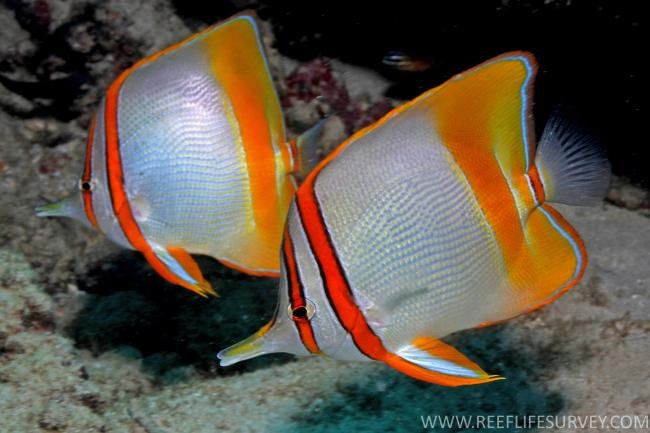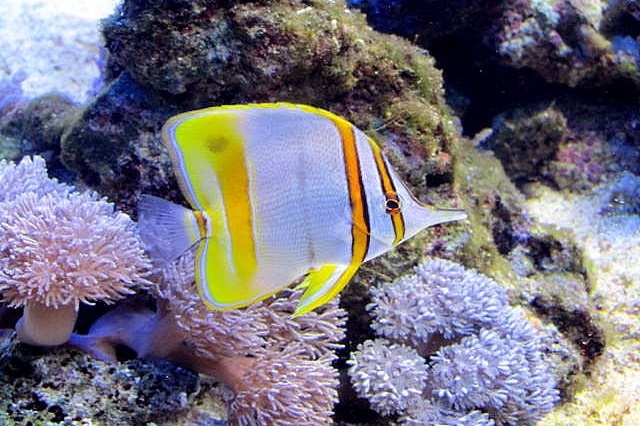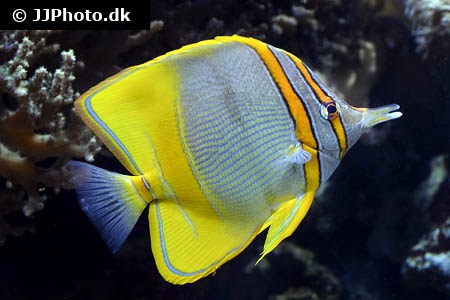Chelmon marginalis



| Latin name | Chelmon marginalis - Richardson, 1842 |
|---|---|
| Local name | Margined coralfish |
| Family | Chaetodontidae - Chelmon |
| Origin | Australia, Central/West Pacific |
| Max length | 18 cm (7.1") |
| Minimum volume |
600 l (158 gal) |
|---|---|
| Hardiness |
Average |
| Suitable for aquarium |
Experience, preparation and extra care required |
| Reef safe |
Often reef safe |
| Aggressiveness | Docile but might be aggressive towards similar species |
| Recommended |
Larger crustaceans (Shrimp, crabs...) Other invertebrates Small crustaceans (Krill, mysis, artemia...) Zooplankton (Cyclops, pods...) |
|---|---|
| Maybee |
Large polyp stone coral (LPS) Soft coral |
This species likes to eat tubeworms.
This species sometimes nibbles at clams including Tridacna species.
This species must be fed with an appropriately varied diet.
There is a greater chance of success with this species if one can supply a living feed to allow it to adapt to the tank.
This species thrives best when there is a sufficiently large amount of micro life (copepods, amphipods or similar) in the aquarium, so that the it can always find their own food.
This fish requires feeding several times a day, especially when newly added.
When the fish can find its natural food in the aquarium it requires less frequent feeding.
These fish eat exceptionally slowly and can be very selective feeders.
It can therefore be problematic to provide it with a sufficient and varied diet, in an aquarium with other, faster feeding species.
They can live as a pair provided they are introduced simultaneously.
This species is very shy and docile, so one should be careful when keeping it with more aggressive fish.
This species can refuse to eat when newly introduced.
Normally however, they begin to eat within about a week, but it's advantageous if they can find their own food in the aquarium.
The Butterflyfish are known for their attractive patterns and colours. They are closely related to Angelfishs, but can always be distinguished, as they lack the spines on each side of the head of the Angelfish.
A smaller group of these fish will seek out primairily soft corals, like Zoanthus. A larger part of the species will target different types of LPS corals. Butterflyfish are also known to seek out anemones, tubeworms and bristleworms.
Therefore it is important to choose the correct species in relation to the corals wanted, if one desires to keep Butterflyfish in a coral-aquarium.
Bristleworms, tubeworms and other small invertebrates are also a part of the diet for many Butterflyfish.
It can be problematic, with many of these species, to get them eating in the beginning, but many of the species cannot resist live zooplankton or live mussels with crushed shells. Another option is to mimic their natural behaviour by stuffing their food into coral skeletons or stones.
They ignore most other fish and are generally peaceful, therefore multiple Butterflyfish will have no problem living together. One should however be cautious about keeping similar species together unless they are a couple.
As these fish can be difficult to acclimatize and get feeding, it is important to buy healthy fish, to avoid having to deal with more problems. Make sure to check that they do not have parasites or any visible infections.
There are some species that should not be kept in an a aquarium, as they are food specialists and will almost always refuse to eat replacement foods. It can be possible to breed some species, which will eat frozen foods. Otherwise the only way to keep food specialists is by feeding them their natural diet, which consists of live SPS or LPS corals for example.
| Aquarium trade | Yes |
|---|---|
| Distribution | Western Pacific: northern Australia (from Western Australia to the Great Barrier Reef) and Papua New Guinea (Ref. 6192). Closely resembles Chelmon rostratus. |
| Danish common names |
Uplettet pincetfisk |
| English common names |
Margined coralfish |
Tristan Lougher. 2013. Buyer Beware: The Copperband Butterflyfish (Chelmon rostratus) - Tropical Fish Hobbyist Magazine - (English)
Bob Fenner. The Chelmon Butterflyfishes - Wet Web Media - (English)
Scott W. Michael. 2004. Angelfishes and Butterflyfishes (Reef Fishes Series Book 3) TFH Publications / Microcosm Ltd. - (English)
Bob Fenner. Butterflyfishes; Separating the Good Ones and Those You Don't Want - Wet Web Media - (English)
Collection of links to additional information - Wet Web Media - (English)
Tea Yi Kai. 2014. Reef Nuggets 2: Aquatic Lepidopterans for your reef (Revised edition) - Reef Builders - (English)

